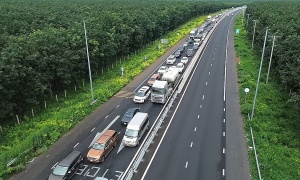Binh Tan Investment JSC, the developer of Ham Kiem II Industrial Park, held a conference at the park which drew local leaders along with investors from Japan, India, and localities across Vietnam.
This was an opportunity to showcase the development potential of Ham Kiem II and served as a bridge for Japanese companies and international partners to connect, expand strategic cooperation, and help increase the occupancy rate of industrial zones in the province.
 |
| Duong Thi Kieu Anh, vice chairwoman of HZ Group and vice chairwoman of Binh Tan Investment JSC, the developer of Ham Kiem II Industrial Park |
According to Duong Thi Kieu Anh, vice chairwoman of HZ Group and vice chairwoman of Binh Tan Investment JSC, Ham Kiem II Industrial Park is oriented to become an integrated industrial–logistics hub, serving the long-term growth of the entire region.
“Investing in and developing IPs is a challenging yet highly meaningful field. Industry is the foundation of the future, a successful IP will create thousands of jobs, enable businesses to operate with confidence, promote sustainable local development, and help integrate Vietnam more deeply into global value chains,” she emphasised.
“In April 2025, when we officially took over Ham Kiem II, we saw here the opportunity for a strategic area to rise and become a new industrial logistics hub, thanks to its seaport, expressways, airport, and North–South railway connectivity,” Kieu Anh added.
 |
| Nakayama Yasuhide, former State Minister of Foreign Affairs, former State Minister of Defence, and former State Minister of the Cabinet Office of Japan |
Nakayama Yasuhide, former State Minister of Foreign Affairs, former State Minister of Defence, and former State Minister of the Cabinet Office of Japan, highly appreciates the Vietnam-Japan relationship, which has flourished over five decades, evolving from initial economic and cultural cooperation into today’s Comprehensive Strategic Partnership founded on mutual trust and reliability.
“This event exemplifies that enduring friendship while creating new opportunities for investment, trade, and industrial cooperation,” Yasuhide said.
“At present, many Japanese businesses are seeking opportunities to invest and expand production in Vietnam,” he added.
Nguyen Hong Hai, vice chairman of Lam Dong People’s Committee, added that the province enjoys many economic development advantages, especially in coastal areas with well-connected transport infrastructure.
“The 180-km section of the North-South Expressway running through the province has been completed, cutting travel time to Ho Chi Minh City to just 2.5 hours. Meanwhile, National Highway 1A has been fully upgraded,” Hai added.
Phan Thiet Airport is expected to begin civilian operations in 2026, alongside the existing North-South railway and the planned high-speed railway project under construction. Vinh Tan International General Port has also gone into operation, facilitating maritime trade.
With the participation of enterprises, the close cooperation of provincial authorities and agencies, and particularly the efforts of Ham Kiem II Industrial Park investor in investment promotion, Lam Dong aims to highlight its advantages and attract more investors to its IZs.
According to the province’s development orientation for industrial parks and economic zones through 2030, with a vision to 2050, Lam Dong will have about 34 IPs covering more than 18,800 hectares, and one economic zone spanning about 27,000 ha, forming a chain of IPs adjacent to Dong Nai and Ho Chi Minh City in the Southern Key Economic Region.
“The province always stands side by side with enterprises and investors in Lam Dong, with a commitment to supporting successful project implementation,” Hai said.
Ham Kiem II Industrial Park covers more than 430 ha, with fully developed technical infrastructure, transparent legal status, and competitive land lease prices, helping investors reduce initial costs.
The park has been attracting the attention of both domestic and foreign investors in diverse fields such as transportation components, electronics, building materials, renewable energy, high-tech agriculture, and food processing.
Currently, the industrial park is developing a 31-ha worker housing project, consisting of 20 apartment blocks with 5,550 worker units and 72 commercial houses, alongside social infrastructure facilities including three kindergartens, a primary school, a secondary school, a general clinic, a cultural house, and sports grounds, helping experts, workers, and employees build stable lives within the park.
To date, Ham Kiem II Industrial Park has attracted 17 projects (including seven foreign-invested projects) with the total registered capital of VND772 billion and $185 million. Currently, seven out of the 17 projects are in operation, creating jobs for more than 4,000 workers.
 |
Ham Kiem 1 IP aims to be trading hub for south-central Vietnam
Ham Kiem 1 Industrial Park in Binh Thuan province is poised to become a significant trading hub for the south central region, due to its comprehensive transport infrastructure. |




